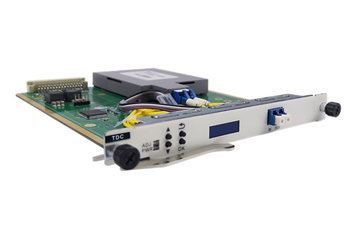Dispersion is one of the transmission properties of the optical fiber, and the optical pulse signal will be broadened in time after transmission in the optical fiber for a distance, which produces inter-symbol interference, thus increasing the error rate and affecting the quality of communication. The tunable dispersion compensation module (TDCM) is created to solve this problem.

Chromatic dispersion is an important factor in the performance of fiber optic communications systems. It is a topic and performance characteristic that is important to be understood and accounted when operating and/or designing TDCM equipment for fiber-based networks.
With different colors of the light spectrum travelling at different speeds due to the differences in refractive index, in the figure above red light travels faster than blue, due to its lower index. Over distance, red and blue will be further separated, thus the signal will be broadened.
Over longer distances, this small "dispersion" eventually adds up to a degree that the receiving end cannot properly distinguish between two consecutive signals as the pulses start to overlap. If not managed, this can cause serious trouble in network communication systems, especially in fast bit rate applications.
TDCM (Tunable Dispersion Compensating Module) is a method using electronic filtering to compensate for dispersion in an optical communications link. It is suitable for high-speed, long-distance WDM transport systems. It can be included in a communications channel to compensate for signal degradation caused by the medium and has the ability to adjust the dispersion compensation value according to the characteristics of the optic fiber, which can the signal transport in long distance in a good way.
Sintai TDCM is a tunable, fully integrated compensator that provides accurate dynamic control of chromatic dispersion for a variety of applications. Our TDCM instrument is featured with the fiber-bragg grating (FBG) technology, which has a broad dispersion range and operational bandwidth. It is available in card type and rackmount versions. The control software interface and hardware button allow for easy integration and minimal setup time for experimental configurations. Sintai TDCM has the following advantages:
• Adjustable
• ± 1200ps/nm dispersion tuning
• Flat Transmissivity
• Multi-channel colorless ITU grid operation
• Low latency
• Low insertion loss, tuning power, and polarization dependence
• G.652 slope matching
• Multi-channel
• The dispersion compensation range is large
• Transparent and does not change the optical signal.
• Simple structure
• Convenient maintenance
• Safe and reliable
In optical fiber communications, dispersion compensation modules (DCM) (also called dispersion compensation units, DCU) can be used for compensating the chromatic dispersion of, e.g., a long span of transmission fiber. A dispersion-compensating module is often placed between two fiber amplifiers.
One way to decrease chromatic dispersion is to narrow the spectral width of the transmitter. Lasers, for example, have a more narrow spectral width than LEDs. A monochromatic laser emits only one wavelength and therefore, does not contribute to chromatic dispersion.
A wavelength where the group delay dispersion of a fiber or a material is zero. Categories: general optics, fiber optics and waveguides. Formula symbol: λ0.
A dispersion compensating module (or DCM) is used to compensate the cumulative dispersion in a single-mode fiber and a dispersion coefficient is used to characterize the dispersion value. The value for regular SMF is around +16~17 ps/(nm*km) at 1550nm.
The TDCM (Tunable Dispersion Compensating Module ) is used to compensate dispersion for optical signals. For WDM: DCM modules are installed in DCM frames and are used to compensate for the positive dispersion of transmission fibers to help maintain the shape of a propagated signal. It is very flexible in the application with varible values.
Tunability in DWDM has been a key requirement for the technology's maturity over the years from the introduction of tunable lasers, broadband receivers, and variable gain amplifiers.